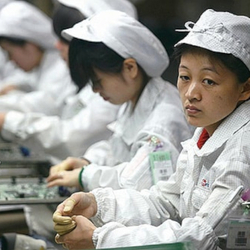Code Exploits
Six years ago the press lit up with stories about how smartphones are made. Like earlier revelations about Nike trainers and other apparel made in sweatshops it was an already too familiar story of brutalised, over-worked and under-paid child labour in factories around the world. In 2018 when the Guardian broke a story based on a book by Brian Merchant 1 of suicidal young women throwing themselves from the roof of Chinese prison-factories, the response of the public was tepid.
People simply could not process the idea that their precious iPhones were not actually made by Apple, by well fed white Americans in the green campuses of Cupertino, but by thirteen year old's in dark, satanic Chinese factories. We simply went into denial. In response the abusers had anti-suicide nets installed around the factory to scoop-up falling bodies and recycle them efficiently back onto the production line.
The factory bosses had journalists beaten up and, with the help of BigTech and mainstream media played the Western press with apologetic, disinformation and fake stories of happy workers.
Regardless, poor working conditions in electronics manufacturing continues today in sites around the world that supply cheap labour in slack heath and safety regimes. Workers suffer extreme pressure, physical brutality like crippling working postures and no bathroom breaks, psychological abuse, humiliation and exposure to mutagenic chemicals and radiation.
As well as the workers, we exploit resources to get our gadgets. In terms of energy costs, by the time a tiny iPhone is created a quarter gigajoule of raw energy is consumed; in silicon wafer processing, aluminium smelting, circuit board manufacture and copper extraction. About 25kg of CO2 is produced and ten thousand litres of clean, filtered and processed cooling water is consumed - in a world where clean drinking water is in increasingly short supply.

